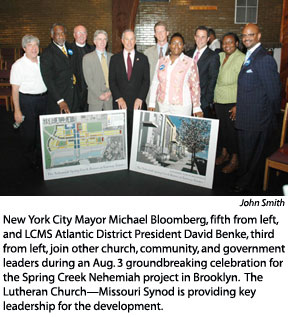By Kim Krull
In the early 1980s, The Lutheran Church—Missouri Synod stepped up as the first denomination to financially commit to a new church-based housing program that dared to transform a devastated, inner-city neighborhood and turn 
Twenty-six years and 2,900 new homes later, some of those original homeowners joined church leaders and New York City Mayor Michael Bloomberg at the Aug. 3 groundbreaking celebration for the newest Nehemiah development.
Again, the LCMS provided key support and leadership.
“The Nehemiah housing projects in New York City have been a tremendous way to make the dream of home ownership real for so many lower-income people who otherwise would not have been able to own their own home,” said Janet Johnson, treasurer for the board of the LCMS National Housing Support Corporation (NHSC), which is providing funding to make possible a $1 million Lutheran Church Extension Fund (LCEF) loan to East Brooklyn Congregations (EBC) for the new Nehemiah community.
“We truly are putting our faith into action by participating in rebuilding once-blighted communities so they can be filled with hope and be safe, nurturing places for the next generations to live and grow,” Johnson added.
On hand for the groundbreaking celebration were leaders of the EBC, the multi-denomination association that launched the Nehemiah Plan for affordable housing in 1983. Two LCMS congregations in Brooklyn — St. Peter and Risen Christ — are veteran EBC members whose determination to remain in and serve their inner-city parishes helped lead to the Synod’s first Nehemiah investment.
“For working-class families, this (Nehemiah) is an ownership option,” said Dr. David Benke, St. Peter’s pastor and president of the LCMS Atlantic District, who gave the opening remarks at the Spring Creek celebration. “For the church, it’s a mission opportunity.”
Rev. Steven Olsen called the Nehemiah program “a tremendous blessing and stabilizer” for Risen Christ and its community. “I am certain that some of the most devoted members of our congregation would have been forced to move if not for the opportunities and improvements brought about by Nehemiah,“ he said.
The newest Nehemiah site is a former landfill. “[It’s] a wasteland — a place where people dumped bodies after killings,” Benke said. “But that’s going to end. Again, lawless behavior will be overwhelmed by the purposeful action of people engaged in appropriate ecumenical collaboration, sharing money, and sharing leadership.”
Spring Creek is the fourth Nehemiah development in the Brooklyn area. The affordable housing effort is named after the Old Testament prophet who led the rebuilding of Jerusalem.
To help make the vision for community revitalization a reality, the LCMS National Housing Support Corporation — the housing ministry arm of LCMS World Relief/Human Care — has committed to raise funds for the interest portion of the LCEF loan to the EBC. The Synod’s Atlantic District also has committed future funds for the loan interest.
“The [National Housing Support] Corporation’s subsidy encouraged the Atlantic District and enabled a national and regional partnership with the EBC that all our ecumenical partners realize is unique, durable, and repeatable,” Benke said. “The movement of funds nationally and regionally to local areas of need and potential is going to multiply LCMS mission and ministry opportunity.”
The Atlantic District’s Task Force on Human Care, led by Judy Benke, Kathy Jagow, and John Mesloh, “has worked tirelessly,” Benke said, to help turn the former landfill site into a safe, decent community.
Construction has begun on Spring Creek’s first phase: 184 homes in a development that ultimately will include 2,100 homes, a new school, parks, and retail space.
More than 18,000 people responded to the announcement about the new affordable housing community, which is limited to first-time homeowners. The starting unit price is $168,000 for the factory-built, modular homes, well below the average cost of New York City housing, Benke said.
EBC members expect the same dramatic transformation at Spring Creek they have seen at other Nehemiah developments. In those communities, residents tend their lawns where drug dealers once roamed. Crime rates have dropped. Both St. Peter and Risen Christ draw congregation members and leaders from Nehemiah neighborhoods.
Some of the first Nehemiah residents spoke at the Spring Creek celebration. “They told of living in public housing and never dreaming they could own a home,” said Rev. Carlos Hernandez, director of Districts and Congregations with LCMS World Relief/Human Care, who addressed the nearly 1,000 people on hand for the groundbreaking. “They said Nehemiah made it possible.”
In addition to the LCMS, other providers of no-interest construction financing for Spring Creek are St. Paul Community Baptist Church, the Vincentian Religious Order (Roman Catholic), and the Episcopal Diocese of Long Island.
Since that pioneering development in Brooklyn, the LCMS has been involved in Nehemiah efforts in Memphis, Tenn., and Chicago. Nehemiah-inspired programs operate throughout the U.S.
The Spring Creek Nehemiah is one example of how the LCMS National Housing Support Corporation is working “to provide resources and help our parishes and our districts step into their role as good corporate citizens of their communities,” said NHSC President Rev. Matthew Harrison. ”Our theology drives us to act in love, help our neighbors, and make a difference in our communities and in our world. Where this happens, proclamation of the Gospel also thrives.”
The LCMS National Housing Support Corporation was established by the LCMS Board for Human Care Ministries to assist LCMS congregations, districts, social ministry organizations, and other partners in developing capacity for local housing initiatives.
For information about supporting the new Spring Creek Nehemiah or getting involved with a local community revitalization effort through the NHSC, contact NHSC Executive Director Marie Kienker at (800) 248-1930, Ext. 1392, or marie.kienker@lcms.org.
Posted Aug. 24, 2006
